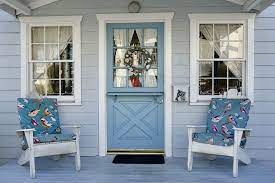Dutch doors, with their distinctive divided design, have a unique charm that has transcended time. Originating in 17th-century Netherlands, these doors were originally known as stable doors, designed to keep animals out while allowing light and air to enter. Today, Dutch doors have found their way into homes, blending nostalgia with modern functionality. In this article, we’ll explore the characteristics, benefits, and design considerations that make Dutch doors a delightful and practical addition to contemporary living spaces.
The Split Personality:
What sets Dutch doors apart is their distinctive split design. Unlike traditional doors that open and close as a single unit, Dutch doors are horizontally divided into two sections—one upper and one lower. This allows homeowners to open and close each section independently, offering a delightful touch of versatility. The divided design is not only aesthetically charming but also serves a functional purpose, providing the option to keep the bottom half closed while allowing the top half to remain open.
Nostalgia and Timeless Appeal:
Dutch doors evoke a sense of nostalgia, harking back to simpler times when functionality and craftsmanship were paramount. Despite their historical roots, these doors have a timeless appeal that seamlessly integrates with various architectural styles. Whether adorning a quaint cottage or a modern farmhouse, Dutch doors add a touch of character and charm to any home.
A Breath of Fresh Air:
One of the standout features of Dutch doors is their ability to invite the outdoors inside. By opening the top half while keeping the bottom half closed, homeowners can enjoy a refreshing breeze without compromising security. This feature is particularly advantageous for kitchens, nurseries, or any room where controlled ventilation is desired.
Child and Pet-Friendly Design:
The divided nature of Dutch doors makes them inherently child and pet-friendly. Parents can keep an eye on little ones or furry friends without fully opening the door. The bottom half acts as a convenient barrier, preventing toddlers or pets from wandering into unsafe areas while still allowing interaction and supervision.
Indoor-Outdoor Connectivity:
Dutch doors excel at enhancing the connection between indoor and outdoor spaces. When both halves are open, the door becomes a seamless transition point, blurring the boundaries between the interior and the patio or garden. This indoor-outdoor connectivity creates a dynamic living experience, especially in homes with well-manicured outdoor areas.
Versatility in Design:
Dutch doors come in a variety of designs and materials, offering versatility to suit different design preferences. Whether crafted from wood, fiberglass, or steel, Dutch doors can be customized to complement the architectural style of a home. Paneled or louvered options provide additional design choices, allowing homeowners to tailor the door to their aesthetic preferences.
Increased Security:
While Dutch doors may exude a quaint charm, they are by no means flimsy. Their divided design can enhance security. Homeowners can keep the bottom half closed and locked while opening the top half to communicate with visitors or accept deliveries. This added security feature makes the Dutch door a practical choice for those seeking both aesthetics and peace of mind.
Cozy Kitchen Appeal:
Dutch doors are often associated with cozy kitchens, where their charming design enhances the overall atmosphere. Placing a Dutch door in a kitchen provides an opportunity to create a welcoming and homey ambiance. It also allows for easy communication between family members while cooking, fostering a sense of togetherness.
Considerations for Installation:
Installing Dutch door requires attention to detail to ensure proper functionality. The door frame and hardware must be precisely aligned to allow for smooth opening and closing. Professional installation is recommended to guarantee that the door operates seamlessly and securely. Well-installed Dutch door become a focal point, adding both visual interest and functionality to a space.
Weather Resistance:
Given their divided design, Dutch doors may present challenges in terms of weather resistance. Proper sealing and weatherstripping are crucial to prevent drafts, especially in regions with harsh weather conditions. Choosing high-quality materials and finishes ensures that Dutch door can withstand the elements and maintain their charm for years to come.
Maintenance Requirements:
Regular maintenance contributes to the longevity and performance of Dutch door. This includes inspecting and lubricating hinges, cleaning surfaces, and addressing any signs of wear or damage. Routine care ensures that the divided sections continue to operate smoothly and that the door remains an enduring element in the home.
Conclusion:
Dutch doors are a delightful blend of charm and functionality, offering a unique character to homes of all styles. Their timeless appeal, child and pet-friendly design, and versatility in indoor-outdoor connectivity make them a favored choice for those seeking a touch of nostalgia in modern living. As homeowners continue to prioritize both aesthetics and practicality, Dutch doors stand as a charming testament to the enduring allure of thoughtful design in contemporary homes.

